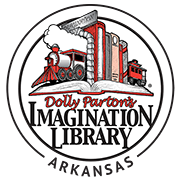Arkansas Imagination Library
READING TO YOUR CHILD0-24 MONTHS
Why is Baby Communication Important at Birth?
Nonverbal cues like eye contact, cooing, crying and listening are your baby’s “language” to tell you needs, wants, and feelings. When parents respond to their baby’s gestures, they are building the very architecture of their brain, determining the foundation for future language, communication, and relationship development.
“Serve and Return” Interaction Shapes the Brain
All you need do is smile, talk, sing, read, play and respond to your baby. It’s called “serve and return” interaction. This back-and-forth process is fundamental to the wiring of the brain, especially in the earliest years. Serve and return interactions help parents create a safe and secure environment for infants, and they help infants build a realization that they’re being taken care of and understood.

Themes and Concepts
- Emphasis on the development of sight and vision with big text and bright colors
- Teaching sensory skills through touch with thick, board pages
- Rhyme and rhythm of words in a repetitive style
- Simple and easy-to-use everyday text for vocabulary development
- Minimal text with engaging, “point-and-say” illustrations
- Playful sounds of everyday characters and sing along text to enhance auditory skills
- Nurturing and attachment themes in sing-song patterns
Tips to Try
- Help your baby to explore the book. Let your baby turn the pages, grab, or even chew on it.
- Point out interesting pictures and take the time to ask questions as you read. Say, “Look at the butterfly.” Cover it and ask, “Where is the butterfly?” Uncover it and say, “Peek-a-boo butterfly!”
- Stay on a page for as long as your baby is interested. Turn the page or stop reading when your baby looks away or seems tired or bored.
- Read with joy and excitement. Use different voices for different characters.
- Ask questions your child can answer by pointing. You can say, “Where’s the doggie?” or “Where’s the happy baby?” or “Who says meow?”
- Imitate the sounds your child makes while looking at a picture. Then add a very short phrase, such as, “Moo, the cow says moo.” Copy your reactions to the book you are enjoying together.
- Speaking in slow, short sentences and waiting for your child to take a turn talking helps him understand.
- Let your toddler give a picture a name; then add a comment like: “Yes, a plane! The plane is flying. The plane is flying in the sky.”
- Help your child pretend to be a character in a book. You can pretend to feed a baby or be puppies, barking and running after each other.
2 -3 YEARS

Themes and Concepts
- Continue sensory concepts from year one and build upon them, such as sight, auditory, and touch skills
- Repetition of everyday words to build vocabulary development
- Predictability of plot lines to generate conversation and engagement
- Development of motor skills and accessibility for child to hold and turn pages
- Emphasis of “Self-help” activities – things children can do, things familiar in their daily life to build upon the story
- Use of real photo illustration child can recognize
- Familiar nursery rhymes with a focus on body awareness, teaching the child basic body parts
- Teaching basic colors, letters, and numbers
Tips to Try
- Cuddle up with your child on your lap.
- Look at your child as you read.
- Let your child lead.
- Active Reading! In active reading, an adult shares a picture book with a child and provides the child with multiple opportunities to talk about and engage with the pictures, words and ideas in the book. CLICK HERE for great resources on Active Reading.
- Ask your child to point out things in the pictures and talk about them.
- Use the pictures to teach new words. Say, “See the trumpet? A trumpet is a loud instrument that makes music.” Then pretend to play the trumpet.
- Ask questions about the story. “What are the bears doing in this picture?” Pause and then help your child answer. Leave room for your child to make things up.
- Act out parts of the story.
- Use the story to start a conversation about something you and your child have done together.
- Start a conversation by repeating an important word your child has just said and wait for your child to say something more.
- Read with joy and enthusiasm! Use different voices for different characters.
- Count pictures and wait for your child to repeat the numbers after you.
4-5 YEARS

Themes and Concepts
- More complex stories and characters featuring hero conflict and resolution
- More serious subject matter, teaching diversity of others, environment, and tolerance of different cultures
- Humorous stories with playful plotlines
- Continuation of familiar Nursery rhymes and poetry repetition
- Focus on school preparation and readiness
- Use rebus (pictures used for words) to develop reading comprehension
- Introduction of non-fiction titles and traditional folk tales
- Moral emphasis on gratitude and appreciation
Tips to Try
- Read with expression, using different voices for different characters.
- Emphasize rhythms and rhymes in stories.
- Encourage your child to repeat what you say, comment on it, and ask questions.
- Place books in a child-accessible area, and give him a chance to choose his own books for story-time.
- Read stories again and again.
- Take the opportunity to familiarize your child with the alphabet.
- Ask your child to tell you about the pictures and the story.
- Point out colors, shapes, numbers, and letters and ask him to find them in the books you are reading together.
- Point out written words in the world around you, like on traffic signs and on food labels in the grocery store.
- Ask your child to find a new word each time you go out together.
